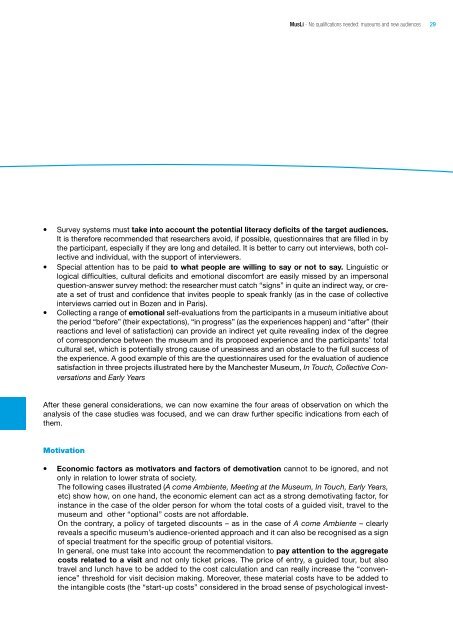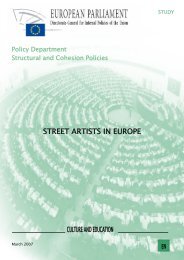MusLi (Museums Literacy) - Fondazione Fitzcarraldo
MusLi (Museums Literacy) - Fondazione Fitzcarraldo
MusLi (Museums Literacy) - Fondazione Fitzcarraldo
You also want an ePaper? Increase the reach of your titles
YUMPU automatically turns print PDFs into web optimized ePapers that Google loves.
<strong>MusLi</strong> - No qualifications needed: museums and new audiences<br />
• Survey systems must take into account the potential literacy deficits of the target audiences.<br />
It is therefore recommended that researchers avoid, if possible, questionnaires that are filled in by<br />
the participant, especially if they are long and detailed. It is better to carry out interviews, both collective<br />
and individual, with the support of interviewers.<br />
• Special attention has to be paid to what people are willing to say or not to say. Linguistic or<br />
logical difficulties, cultural deficits and emotional discomfort are easily missed by an impersonal<br />
question-answer survey method: the researcher must catch “signs” in quite an indirect way, or create<br />
a set of trust and confidence that invites people to speak frankly (as in the case of collective<br />
interviews carried out in Bozen and in Paris).<br />
• Collecting a range of emotional self-evaluations from the participants in a museum initiative about<br />
the period “before” (their expectations), “in progress” (as the experiences happen) and “after” (their<br />
reactions and level of satisfaction) can provide an indirect yet quite revealing index of the degree<br />
of correspondence between the museum and its proposed experience and the participants’ total<br />
cultural set, which is potentially strong cause of uneasiness and an obstacle to the full success of<br />
the experience. A good example of this are the questionnaires used for the evaluation of audience<br />
satisfaction in three projects illustrated here by the Manchester Museum, In Touch, Collective Conversations<br />
and Early Years<br />
After these general considerations, we can now examine the four areas of observation on which the<br />
analysis of the case studies was focused, and we can draw further specific indications from each of<br />
them.<br />
Motivation<br />
Economic factors as motivators and factors of demotivation<br />
• cannot to be ignored, and not<br />
only in relation to lower strata of society.<br />
The following cases illustrated (A come Ambiente, Meeting at the Museum, In Touch, Early Years,<br />
etc) show how, on one hand, the economic element can act as a strong demotivating factor, for<br />
instance in the case of the older person for whom the total costs of a guided visit, travel to the<br />
museum and other “optional” costs are not affordable.<br />
On the contrary, a policy of targeted discounts – as in the case of A come Ambiente – clearly<br />
reveals a specific museum’s audience-oriented approach and it can also be recognised as a sign<br />
of special treatment for the specific group of potential visitors.<br />
In general, one must take into account the recommendation to pay attention to the aggregate<br />
costs related to a visit and not only ticket prices. The price of entry, a guided tour, but also<br />
travel and lunch have to be added to the cost calculation and can really increase the “convenience”<br />
threshold for visit decision making. Moreover, these material costs have to be added to<br />
the intangible costs (the “start-up costs” considered in the broad sense of psychological invest-<br />
29






